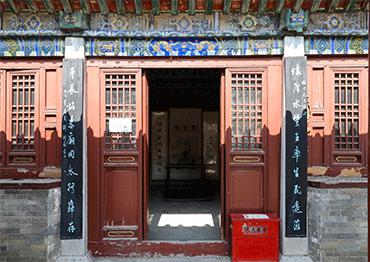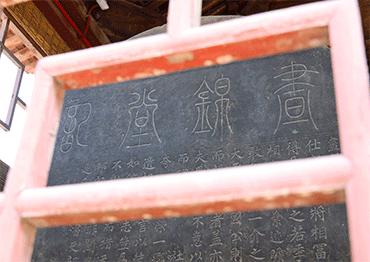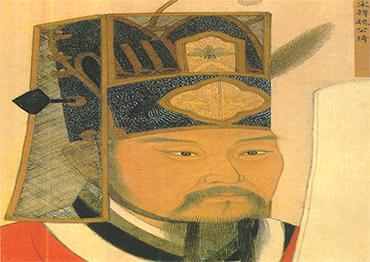Han Qi (1008-1075) served as prime minister through the reigns of three Northern Song emperors – Renzong, Yingzong and Shenzong. Despite the devastating political factions within the Song court, he still managed to hold this post for 10 consecutive years – the only person throughout the dynasty who was able to do so.
Han was a talented writer and calligrapher. His poetry reflected the life of his time and demonstrated his unique insights. Profoundly influenced by Tang Dynasty (618-907) calligrapher Yan Zhenqing, his calligraphy was structurally rigorous and powerful. One of his letters to his long-time friend Fan Zhongyan was so favored by Qing Dynasty Emperor Qianlong, who ruled from 1735 to 1796, that he stamped six seals upon it to show his appreciation of it as a calligraphic work.
The Temple of the Duke of Han was first built during the late Northern Song Dynasty. And though it was later destroyed in war, it was rebuilt on its original site during the Mongolian Yuan Dynasty (1271-1368).
The Hall of Daytime Elegance was constructed while Han Qi was serving as governor of Anyang. But for the convenience of commemoration, it was relocated to its current site during the Ming Dynasty (1368-1644).
The site excels above its counterparts especially for a stone stele with inscriptions of the record of its owner’s life. The stele presents “marvels” in four aspects – the achievements of its owner, the writings inscribed, the calligraphy of its text, and its head, which is the intricately carved upper portion of the stele.
Its owner Han Qi was born into a scholar-official family in 1008. His mother was a maid servant to his father when he was an official in Southeast China’s Fujian Province, and was later married to him as a concubine. Han Qi’s father died when he was only 5 years old. His mother took him back to his father’s hometown in Anyang where he was educated under the guidance of his older brothers.
When he was 20, he passed the highest level of the imperial examination. As a literati official recruited through the imperial examination, Han Qi surprisingly established his reputation militarily, but this mostly had to do with the Song’s governance strategy and civil service system.
The Song’s founding emperor Taizu (927-976), who was a military general and ascended the throne through a coup, was determined to make sure that no rival general would become powerful enough to seize his throne the same way he had. He introduced a system of rotation for military leaders to sweep away any potential threats, and he ensured that the civil service was elevated to a higher status than the army by acting as its supervisory body, thus leading to the domination of literati over military officials in the administration of the dynasty, which led to a surplus of literati officials and a shortage of military officials.
On the other front, from its establishment, the Song alternated between war and truce with the Khitans of the Liao Dynasty (907-1125) in the northeast. Emperor Taizu conquered much of Central China, but neither he nor his successors managed to conquer the Liao Dynasty in the north. In fact, the Song emperors were compelled to recognize the Khitan ruler as an emperor in his own right and pay an annual tribute in the form of silver and silk.
A similar situation arose with the Tanguts of the Western Xia in the northwest. In 1040, when the Tanguts attacked the Song, Emperor Renzong, who reigned from 1022 to 1063, entrusted the defense against the Tanguts to literati officials Fan Zhongyan and Han Qi. The Song managed to win a few military victories over the Tanguts at first, but the campaign was ultimately a failure due to a military officer who disobeyed orders. Following his defeat in 1044, Emperor Renzong agreed to pay tribute to the Tanguts in order to maintain a peaceful border and concentrate on consolidating his rule of Central China.
The period when Han and Fan were co-commanders in the Song-Xia war also witnessed one of the greatest moments in their long friendship. Shortly after, they collaborated again in an important, although short-lived reform campaign called the Qingli Reform.
The reform was so named because it took place in year 1043, the third year of the Qingli era – reigns were broken up into periods known by a “reign motto” – under Emperor Renzong. As primary advocate of the reform, Fan Zhongyan attempted to reform the traditional way of conducting governmental affairs. He outlined three sets of reform objectives, including improving administrative efficiency, empowering local governments and strengthening defense.
Han Qi ffrmly supported Fan Zhongyan’s proposals and exerted significant influence in their implementation. During his tenure in local government, Han implemented what could be called a pilot program for Fan’s reform measures and achieved remarkable results, thus providing solid evidence for the wider promotion of these new policies.
However, without the full support of the emperor, these policies were never completely implemented. And worse, the Song court was so plagued with political factions that a backlash from the court’s conservative officials started not long after. The reforms failed after about a year, and Fan Zhongyan was forced to step down as prime minister.
For championing the reforms, Han Qi was expelled from the inner power circle and made to serve in several local positions in Jiangsu, Shandong, Hebei and Henan provinces. Han and Fan last saw each other in 1044, but they always maintained their friendship by exchanging letters and through their literary works.

 Old Version
Old Version



